THE ABYSS
Gist: https://gist.github.com/kcb403/43ff09f15f59c622571d287b8c1f22ee
A mysterious audiovisual performance that evokes the nature of water and the esoterica essence of eastern philosophy. the combination of intense visuals and a spooky soundscape is meant to evoke ominous yet curious feelings in our audience.
For our midterm project, Celine, Gabe, and I were originally inspired by the beauty and mystery of water. We wanted to tie in the essence of water’s movement as well as its calming yet intriguing energy. Gabe created a beautiful soundscape to evoke the serenity of water and we matched this with a stunning visual animation which provokes many inquisitive emotions and draws our audience in a trance. While constructing the final audio output, we also realized our audio and visual experienced evoked a lot of spooky emotions so it actually fits the theme of the recent holiday, Halloween, very well. Our intention behind this project is to simply draw our users in a trance with the ethereal quality of waves of water and allow them new insight into the fabric of our universe. We were inspired by Thomas Wilfred and his works’ connection with eastern philosophy. This connection to eastern philosophy inspired us to include the chanting of the monks in our audio track. Our final outcome aims to achieve the serenity and void of the meditative state.
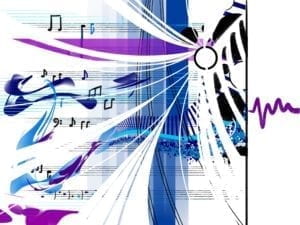
Our project was directly inspired by Thomas Wilfred’s Lumia machines due to the nature of our box, the use of projectors, and the connection to his same sources of inspiration. When developing our soundscape, we decided that having just water sounds was quite monotone, so we decided to opt for a creepier and more intriguing vibe by adding the chanting of monks. This chanting of monks was inspired by a project we watched in class, Lapis, by James Whitney, which also was a project inspired by eastern philosophical ideas.
Another concept that we were directly inspired by is the concept of the Lumia box. The Lumia box not only functioned as a performance device but also a decorative display piece in a house. In the way that the Lumia machine had good form and function, we wanted to create an aesthetic device that contained our own audiovisual performance. In this way, we were then inspired to laser cut an aesthetic box that contained our webcam, water, and allowed for the colored lights to be placed on top. This part of our project was directly inspired by the essence of form and function displayed by the Lumia box.
Our project has three main components, the audio, Max visuals, and physical box construction.
Our audio was created through a combination of Gabe’s efforts as well as my own. Gabe created the main background audio using Ableton, while I created different audio effects that could be added on top of the main soundscape using Logic Pro X. Gabe’s previous knowledge of music production definitely gave him an amazing creative edge which led to a very cohesive soundscape. Meanwhile, I am still new to audio projection, however, I had a fun time learning how to use different synths in order to add fun sounds to our backdrop.
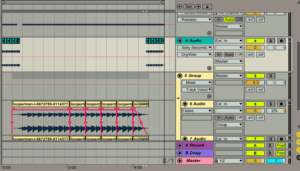
Our visuals were mainly a team effort, achieved through our experimentation of various vizzie components. We gathered a lot of inspiration through the effects shown to us in class. With me guiding the editing of the visuals, our entire team followed the process of deciding which visual editors to apply to our projected video. We decided to choose effects that correlated well with the audio, and then linked the audio outputs to the desired effects in order to create a very psychedelic and wavy image. Our entire process was very experimental, just applying different edits to our webcam, however, once we found an effect that was powerful enough to garner a reaction from the viewers, yet subtle enough to not be too disturbing, we chose that as our middle point. We also connected our external device to different hues and gain settings in order to let our team change certain values throughout the performance not influenced by audio values.
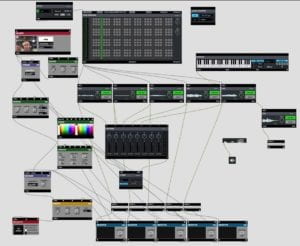
Our physical box, as previously described, is heavily inspired by Thomas Wilfred’s Lumia. We created a very similar box in the way that it contains the entire audiovisual setup. While Wilfred had many versions of the “klaviklux”, we also went through many ideas and trials in the making of our perfect Lumia box. Every part of the box was created in order to efficiently serve its purpose as an aesthetic container of our work.
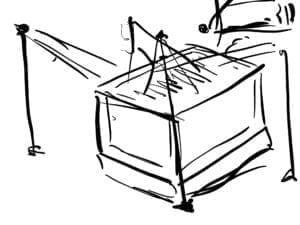
Besides the laser cut sides, our box contains three main components: colored light, video webcam, and a water source. The main box structure is made of two different components. We have a bottom box that is opaque on all sides except the top. The top, translucent tray, has the three shallow trays of water on top. This allows for the light source to shine through. Also in the bottom box is a slit on the side of the opaque wall, which allows for the webcam recorder to show a live stream of the projected image.
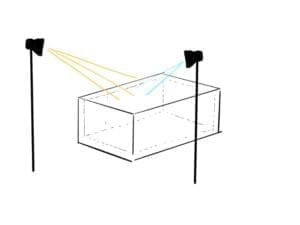
The slit in the side of the opaque wall was in fact not an original component of our box. Right before we were about to laser cut the box, we realized that we had no place to put the camera in order to efficiently record the wave reflections. Therefore, with the measuring of the webcam, we added a slit to the side of the box in our design in order to allow the camera to just fit, but not be too big that extra light would make it into the box and ruin the purity of our wave lights. This decision to add the slit led to the most consistent webcam footage. The camera was hard to set up at first, but once we found the best angle to place it at, we secured it to the side of the box with tape and called it a day.
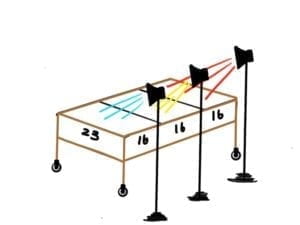
Our second box is a tad smaller than the first box, which allows it to be placed on top with no difficulty. It has, however, no bottom which allows it to be placed over the trays. It is opaque on all sides, with a horizontal slit in the top, which allows for the projector’s light to shine through, bounce off of the water, and create waves of light on the bottom of the boxes, allowing the light to be recorded by the webcam. This slit in the top side was essential as too much light entering the apparatus would have led to the wave reflections being drowned out in too much light. This slit at the top was a later addition as during testing, we realized the reflection of the waves would not appear if we had a too bright and direct light source.
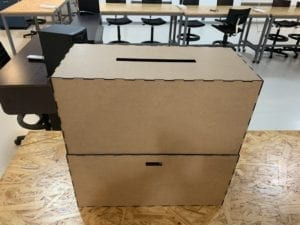
The trays of water on top of the translucent box lid are one of the most essential aspects of our box creation. They contain the water which the light reflects off of and during the performance, we had our group members shake the box apparatus in accordance with the vibe of the music in order that they have control over the way that the visuals play out.
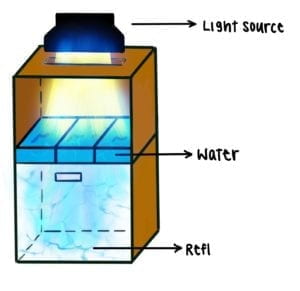
Another change that we enacted was the realization that the visuals would best be projected on a clean, white surface. When testing our constructed box, we realized the visuals did not show up too well on the grainy wooden surface of the material, so we had created a white-paper cutout to place on the inside surfaces of the bottom box in order to have the best background for our visuals to be displayed on. This newer white background allowed for the water reflections to be the clearest and most visible.
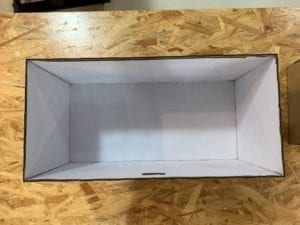
In order to prepare for our performance, we rehearsed it many, many times. We split up the different tasks. I controlled the addition of extra audio tracks while Celine and Gabe traded off who would shake the apparatus and who would control the alteration of certain visual effects. Because I had experience with the audio, I took control of that for the entire experience, while Gabe and Celine switched between their two tasks at the halfway mark during the presentation. One thing that we had worked on before our presentation was making sure all our cues were aligned, and timing ourselves so that our performance fit well within the five-minute mark. This all turned out very well and we had no time complications.
However, we had other complications. Right before we were about to start our performance, the Max program on my computer crashed, which I believe is due to me upgrading my system software to Catalina, while Max still is not optimized for this software. This led to the very specific values of our effects that we had just decided on for the performance to be suddenly lost. Extremely stressed out, we tried to play with the patch in order to return it to normal, however, even putting the settings back exactly how they were originally, there was something that still didn’t sit right with the patch. Our patch originally could be adjusted to any color of the rainbow, however, during the performance it was limited to displaying as either blue or green. This was shocking as our patch relied on the adjustment of color as one of its main reactions to the sound effects that I had cued during the performance. However, even though the visuals didn’t turn out as planned, the audio was easily salvageable as I could place it right back into the cell-midi objects.
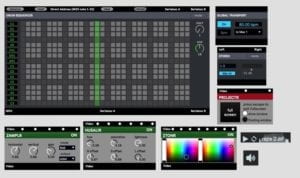
Despite our issues, our roles as performers were fulfilled. The actual performance went entirely well, and we performed all of our previously rehearsed effects exactly as planned, despite a few visual ones. Our beginning, transition, and ending were all so smooth and we worked so good as a team in coordination ourselves and taking action in our roles throughout the performance. Regardless of the side effects of the patch crashing, the performance overall was a very fun and memorable experience. If anything, the complications stimulated our bonding as a team and helped us work together to create the best performance possible minus a few technological setbacks. I definitely think the technological issues have allowed us to retain a more proactive mindset which will help us to work ahead and avoid this issue in the future.
All in all, I think our project was a grand success. Even if our outcome wasn’t perfect, our entire team learned what it is like to take all of our talents and come together to create one amazing piece of art. From our efforts in creating our audio component, soundscape, and laser cut box, this project was one that tested all of our different talents and previous knowledge from other IMA classes. While we had a few difficulties with how our performance turned out due to a few technical issues, I still believe that our final presentation was able to capture the totality of our efforts.